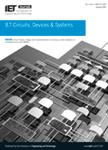版权所有:内蒙古大学图书馆 技术提供:维普资讯• 智图
内蒙古自治区呼和浩特市赛罕区大学西街235号 邮编: 010021

作者机构:Xi An Jiao Tong Univ Dept Microelect Xian Shaanxi Peoples R China
出 版 物:《IET CIRCUITS DEVICES & SYSTEMS》 (IET Circuits Devices Syst.)
年 卷 期:2019年第13卷第2期
页 面:245-250页
核心收录:
基 金:Core Electronic Device Project of China [2017ZX01030204] High-end General Chips Project of China [2017ZX01030204] Basic Software Products Projects of China [2017ZX01030204]
主 题:battery management systems battery powered vehicles field programmable gate arrays secondary cells lithium compounds electric vehicle charging estimation theory lithium-ion battery state of charge sustainable energy SOC estimation algorithm greenhouse gas emission reduction current detection battery currents smart devices electric vehicles clean energy current-free detection algorithm commercial common field-programmable gate array battery working process battery voltages
摘 要:Lithium-ion battery as an efficient, sustainable, and clean energy for electric vehicles (EVs) and smart devices becomes more popular with the worldwide demand for reduction of greenhouse gas emission. In all kinds of applications, an accurate real-time estimation for state of charge (SOC) of battery is necessary. Some conventional methods usually need to sample both battery currents and voltages. This article presents a novel SOC estimation algorithm without current detection. This algorithm just acquires the port voltages of cell to calculate the open-circuit voltage (OCV) which is related to SOC. By extracting a large number of battery voltages based on a step response, some important parameters that can track battery working process are determined. In order to verify the algorithm feasibility and accuracy, it has been tested on a commercial common field-programmable gate array (FPGA) in different application conditions. The algorithm accuracy is mainly limited by model accuracy and sampling sensor accuracy. The maximum error between ideal SOC and calculated SOC by this algorithm is within 4%, and the mean error is about 0.99%. So, this high-feasibility, accredited accuracy, easy integration, and low-cost solution has bright potential in smarter future.